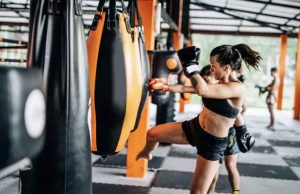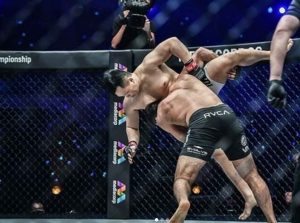While many of the stars of ONE Championship could succeed in the Circle with their martial arts skills, they also use a variety of other exercises, like strength training.
Take Tawanchai PK. Saenchai, who on February 25th, in the co-main event of ONE Fight Night 7: Lineker vs. Andrade II, defends his ONE Featherweight Muay Thai World Title against #2-ranked contender Jamal Yusupov. It goes without saying that the 23-year-old’s strength training programme plays a part in his explosive power.
Strength training is an excellent extra activity for all martial artists, and we break down three reasons why before Tawanchai’s first World Title defence at Lumpinee Stadium in Bangkok, Thailand.
Strength training and Martial Arts games:

Sometimes called cage fighting, mixed martial arts (MMA) is a full-contact combat sport. It incorporates elements of various martial arts and combat sports, including Taekwondo, boxing, judo, and wrestling.
Athletes competing in mixed martial arts (MMA) need to be strong in the body and agile in the feet to succeed in the octagon, an eight-sided ring enclosed by a cage. In this kind of fighting, where manoeuvres must be precise, and calculated, and require speed, strength, and power, all work together. Gaining weight can work to an athlete’s advantage or disadvantage, depending on the weight class.
MMA fighters develop their muscle and agility through intense strength and conditioning regimens. They are taught to punch or move with their entire body without losing their balance.
When done correctly, weight training or resistance training can improve these sports traits. An MMA fighter can enhance their ability to withstand blows to the front of their body by toning the muscles in their chest and abdomen. Fighters can strengthen their triceps and biceps for power, speed, and quick jabs, as well as their shoulders for arm endurance. Additionally, they might strengthen their calves, quads, and hips to improve stability and balance.
These pointers can assist you in getting started, whether your goal is to get stronger or lay the groundwork for future mixed martial arts combat:
- Before beginning a weight workout, warm up (and don’t skip the cool down after).
- Exercise through major injuries, whether they are acute or chronic.
- Unless you are treating or recovering from a weight-training injury, don’t trade off an octagon session for a weight session.
- Ask your coach or personal trainer if they have any recommendations on how to tailor this training regimen to your skills and fitness objectives.
- Take a few weeks off at the end of the season to recover if you intend to compete.
Strength Conditioning Fundamentals:

This training program’s first phase focuses on overall strength and muscle conditioning to get you ready for the octagon. This phase would essentially be used during the early preseason if you were to train seasonally.
If you don’t train in “seasons,” your strength and endurance will progressively increase as you move from one training phase to the next. Once more, the length of each phase will be determined by the fitness level of the individual.
Try kickboxing or shadowboxing in your home fitness studio instead of the octagon if you’re not competing this season and don’t have access to a training facility. Additionally, weightlifting exercises shouldn’t be done before a sparring session in an MMA training programme. If at all possible, it is preferable to perform weight training after working in the octagon or on a different day.
Begin with a single compound movement that targets your upper back, shoulders, forearms, core, and hamstrings.
- Frequency: 2–3 sessions per week for 8–10 weeks
- Type: General conditioning
- Warmup: 10 minutes of aerobic exercise (walking or jogging on a treadmill or outside, riding a stationary bike, or using a cross-training machine such as an elliptical)
- Weight training: 3 sets of 10–12: Romanian deadlifts (RDLs)
- Rest between sets: 30–90 seconds
- Cooldown: 5 minutes of light jogging or walking followed by stretching
Benefits of strength training:

1. Increases Physical Conditioning:
The body is conditioned by strength training to be able to execute martial arts techniques longer and with more intensity. ONE fighters usually engage in three- to five-round matches. Strength training is essential to achieving the required speed, agility, and power to get through these rounds.
Strength training strengthens the muscles involved in kicks, punches, and other martial arts techniques, as well as their power. An athlete can perform better and realise their full potential as a result.
Consider a fighter like Marcus “Buchecha” Almeida, the 17-time BJJ World Champion, who has regularly finished his opponents in the first round, demonstrating the effectiveness of strength training. This is just one more advantage of his physical fitness, and it can also provide you with the strength to finish fights swiftly and forcefully.
2. Improves Balance, Coordination, And Mental Focus:
Your general balance and coordination will improve with strength training, which is necessary for correctly executing martial arts techniques.
Controlling your body’s movements is essential, whether you’re trying to improve your kickboxing technique or get the upper hand in a submission grappling match. Enhancing mental agility and concentration is another benefit of strength training, as these are essential skills for success in the ring and in life.
Interim Muay Thai World Champion Janet Todd and ONE Women’s Atomweight Kickboxing champion are exceptional athletes and mental toughness, but it’s clear that “JT’s” rigorous strength training has contributed significantly to her success in both of these sports.
3. Prevents Joint Injuries:
Strength training can help prevent injuries by protecting the muscles, tendons, and ligaments used in martial arts. Additionally, it increases the range of motion by strengthening the muscles that surround the joints, which promotes flexibility.
By strengthening these essential elements, the joint is subjected to less force, reducing the likelihood of injury during regular training and, eventually, a fight. Furthermore, since stronger muscles can stretch farther, increased elasticity is made possible by improved muscular strength.
The muscular build of an athlete such as ONE Light Heavyweight and Interim Heavyweight World Champion Anatoly Malykhin is well known. But thanks to strength training, “Sladkiy” has been able to maintain his flexibility and keep up his winning streak.
So, this was all about the Martial Arts game and strength training. Also read, Martial Arts & Anxiety- Can Martial Arts help with anxiety?

